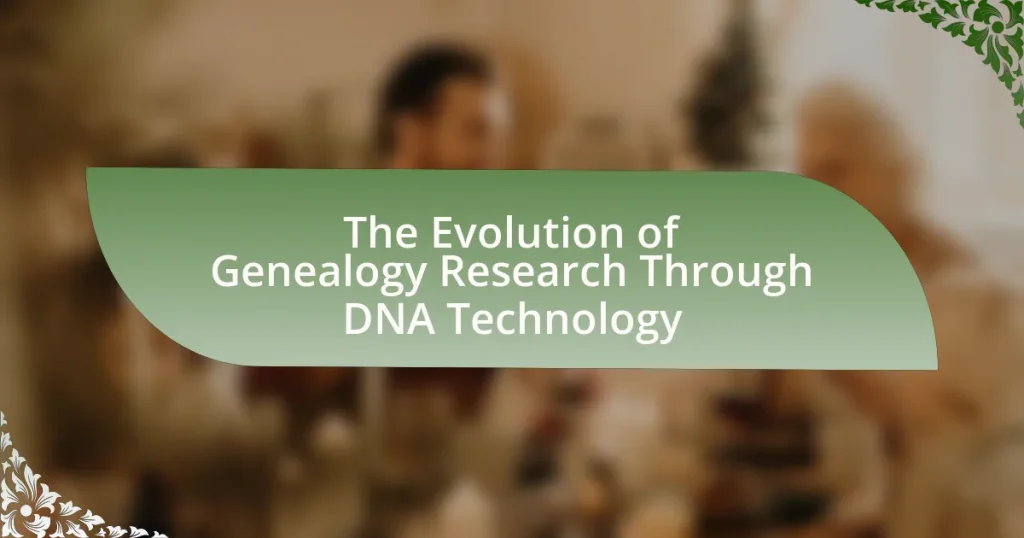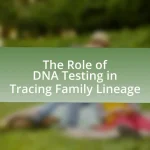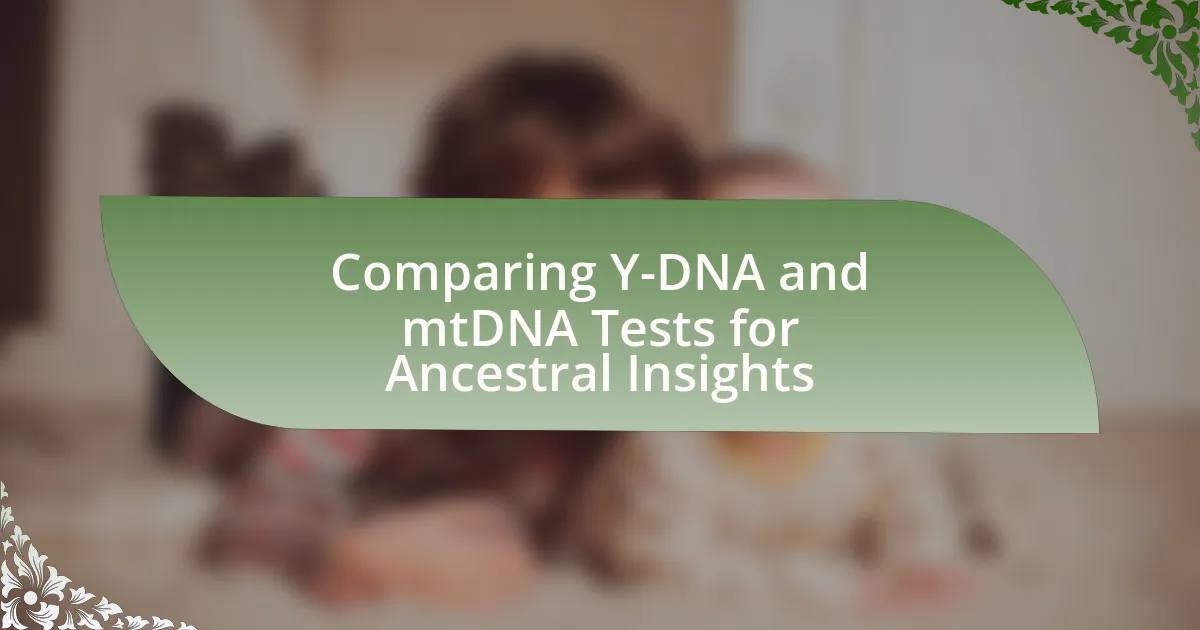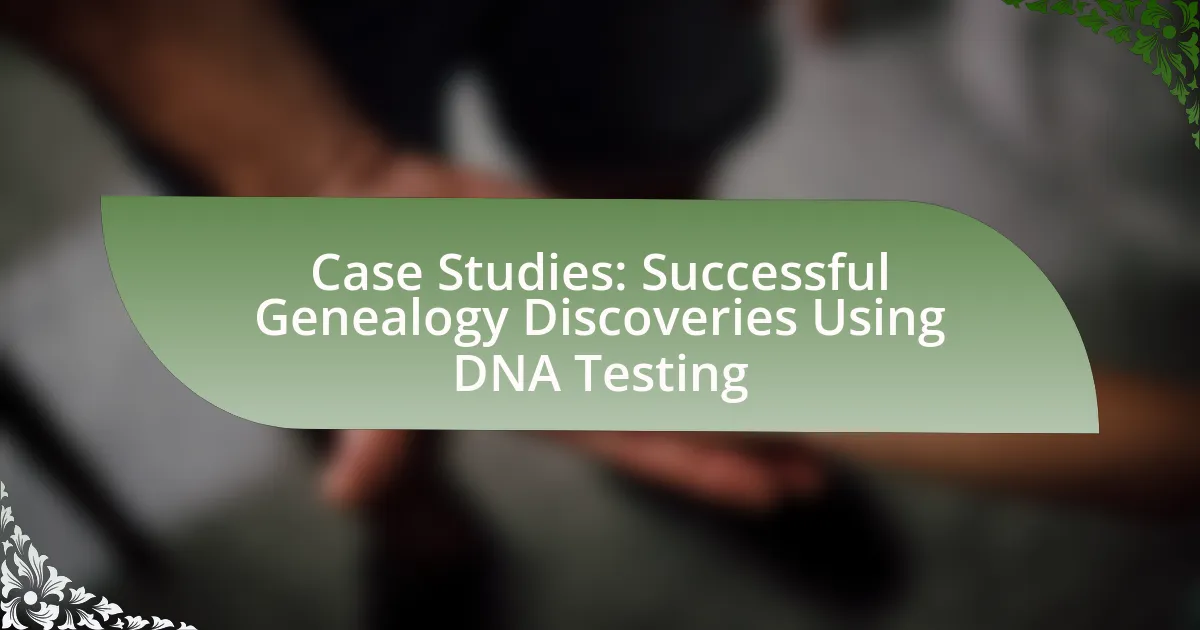The article examines the evolution of genealogy research through the advancements in DNA technology, highlighting its transformative impact on tracing ancestry and understanding genetic heritage. It details the shift from traditional methods, such as historical records and oral histories, to scientific approaches enabled by DNA testing, which began in the early 2000s. Key milestones in DNA technology, including the development of various DNA tests—autosomal, Y-DNA, and mitochondrial DNA—are discussed, along with their implications for enhancing the accuracy of genealogical research. The article also addresses the challenges and ethical considerations associated with DNA testing, as well as the role of commercial DNA testing companies in making genetic genealogy accessible to the public.
What is the Evolution of Genealogy Research Through DNA Technology?
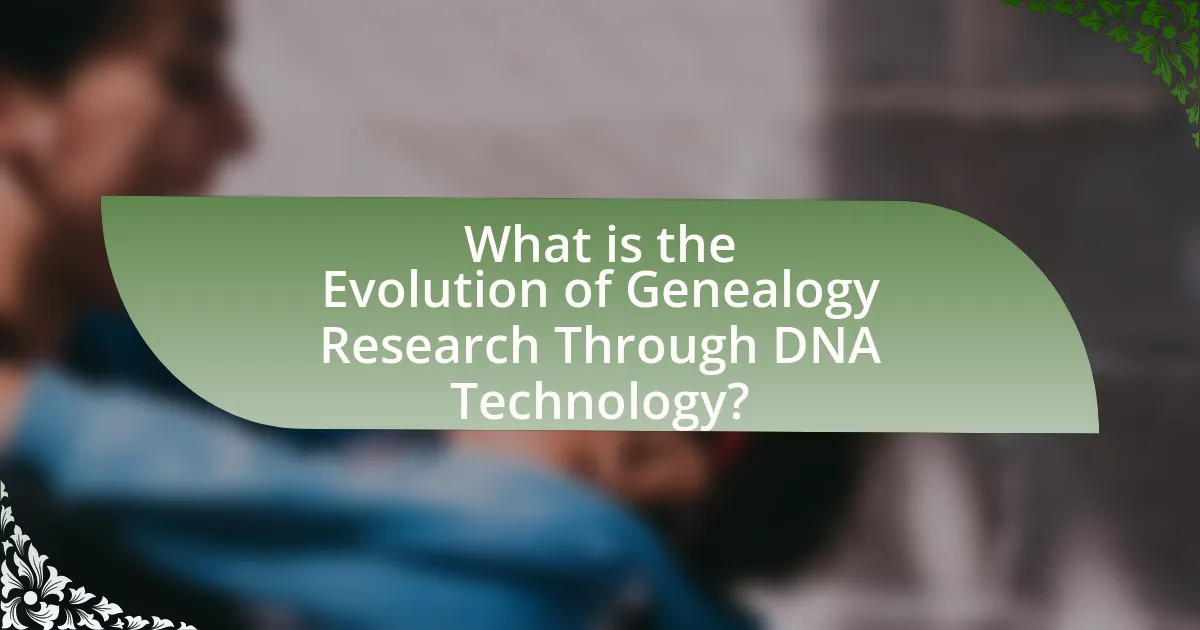
The evolution of genealogy research through DNA technology has transformed how individuals trace their ancestry and understand genetic heritage. Initially, genealogy relied heavily on traditional methods such as historical records and oral histories, which often provided limited information. The introduction of DNA testing in the early 2000s allowed for a more scientific approach, enabling individuals to uncover familial connections and ethnic backgrounds through genetic markers.
As of 2023, advancements in DNA sequencing technology have made it more accessible and affordable, with companies like AncestryDNA and 23andMe offering comprehensive genetic testing services. These services analyze autosomal, Y-DNA, and mitochondrial DNA, providing insights into both direct paternal and maternal lineages. The results have led to significant discoveries, including the identification of previously unknown relatives and the confirmation of ancestral origins, which traditional methods could not achieve.
Furthermore, the integration of large DNA databases has facilitated the identification of genetic matches, enhancing the collaborative aspect of genealogy research. This shift has not only enriched personal family histories but has also contributed to broader historical and anthropological studies, illustrating the profound impact of DNA technology on genealogy.
How has DNA technology transformed traditional genealogy research?
DNA technology has significantly transformed traditional genealogy research by providing precise biological evidence of ancestry. This advancement allows individuals to trace their lineage through genetic markers, which can reveal connections that traditional records may not capture, such as undocumented adoptions or ancestral migrations. For instance, DNA testing services like AncestryDNA and 23andMe utilize autosomal DNA analysis to identify relatives and ancestral origins, offering insights into family trees that were previously difficult to establish. Additionally, studies have shown that DNA testing can confirm or refute family relationships with a high degree of accuracy, enhancing the reliability of genealogical research.
What are the key milestones in the development of DNA technology for genealogy?
The key milestones in the development of DNA technology for genealogy include the discovery of the double helix structure of DNA in 1953, which laid the foundation for genetic research. In 1985, Alec Jeffreys developed DNA fingerprinting, enabling the identification of individuals based on their unique DNA profiles. The introduction of mitochondrial DNA analysis in the 1990s allowed researchers to trace maternal lineage. The launch of direct-to-consumer genetic testing services, such as 23andMe and AncestryDNA in the early 2000s, revolutionized genealogy by making DNA testing accessible to the public. In 2012, the advent of next-generation sequencing technology further enhanced the accuracy and efficiency of genetic analysis, allowing for more comprehensive genealogical research. These milestones collectively transformed genealogy by providing powerful tools for ancestry tracing and familial connections.
How do DNA tests differ from traditional genealogical methods?
DNA tests differ from traditional genealogical methods by providing genetic evidence that can confirm or refute familial relationships, whereas traditional methods rely on historical records and documentation. DNA testing analyzes specific markers in an individual’s genetic material, offering a more definitive link to ancestry, while traditional genealogy often involves piecing together family trees through birth, marriage, and death certificates, which can be incomplete or inaccurate. For instance, DNA tests can reveal connections to relatives that may not be documented in historical records, thus enhancing the accuracy of genealogical research.
Why is DNA technology important for genealogy research?
DNA technology is important for genealogy research because it provides a scientific method to trace lineage and establish familial connections. By analyzing genetic markers, individuals can uncover ancestral origins and verify relationships that traditional records may not confirm. For instance, DNA testing can reveal connections to distant relatives and identify ethnic backgrounds, enhancing the understanding of one’s heritage. Studies have shown that DNA testing can lead to the discovery of previously unknown family ties, with companies reporting that over 30 million people have taken DNA tests for genealogical purposes, significantly expanding the scope of family history research.
What advantages does DNA testing provide in tracing ancestry?
DNA testing offers significant advantages in tracing ancestry by providing precise genetic information that can reveal familial connections and ancestral origins. This technology allows individuals to identify relatives through shared DNA segments, which can confirm or refute traditional genealogical research. For instance, studies have shown that DNA testing can uncover previously unknown relatives, helping to build a more accurate family tree. Additionally, DNA tests can indicate geographic ancestry, revealing the regions where ancestors may have lived, which enhances understanding of one’s heritage. The accuracy of these tests is supported by extensive databases and algorithms that analyze genetic markers, making DNA testing a powerful tool in modern genealogy.
How does DNA technology enhance the accuracy of genealogical research?
DNA technology enhances the accuracy of genealogical research by providing precise genetic information that can confirm or refute familial relationships. This technology analyzes specific markers in an individual’s DNA, allowing researchers to identify genetic connections that traditional methods, such as historical records or oral histories, may not reveal. For instance, autosomal DNA testing can uncover relationships across multiple generations, while Y-DNA and mitochondrial DNA tests can trace direct paternal and maternal lines, respectively. Studies have shown that DNA testing can resolve discrepancies in family trees, with a 2019 study published in the American Journal of Human Genetics indicating that genetic testing can clarify relationships in up to 30% of cases where traditional genealogical methods yield conflicting results.
What challenges have arisen with the use of DNA technology in genealogy?
The challenges that have arisen with the use of DNA technology in genealogy include privacy concerns, misinterpretation of results, and the potential for unexpected familial revelations. Privacy concerns stem from the fact that DNA data can be sensitive and may be shared without consent, leading to ethical dilemmas regarding personal information. Misinterpretation of results can occur when individuals lack the expertise to accurately understand genetic data, which can lead to incorrect conclusions about ancestry. Additionally, DNA testing can reveal unexpected relationships, such as non-paternity events, which can disrupt family dynamics and cause emotional distress. These challenges highlight the complexities involved in integrating DNA technology into genealogical research.
What ethical considerations are associated with DNA testing for genealogy?
Ethical considerations associated with DNA testing for genealogy include privacy concerns, informed consent, and the potential for unexpected familial revelations. Privacy concerns arise because individuals may not fully understand how their genetic data will be used or shared, leading to potential misuse or unauthorized access. Informed consent is crucial, as participants must be aware of the implications of sharing their DNA, including the possibility of discovering unknown relatives or health information. Additionally, unexpected familial revelations can disrupt family dynamics and relationships, as individuals may uncover information about parentage or ancestry that challenges their identity or family narratives. These ethical issues highlight the need for clear guidelines and responsible practices in the field of genetic genealogy.
How do privacy concerns impact the use of DNA technology in genealogy?
Privacy concerns significantly impact the use of DNA technology in genealogy by limiting individuals’ willingness to share their genetic information. Many potential users fear that their DNA data could be misused, leading to unauthorized access to personal health information or genetic predispositions. A survey conducted by the Pew Research Center in 2019 found that 60% of Americans expressed concern about how companies handle their genetic data, indicating a widespread apprehension regarding privacy. This hesitance can result in reduced participation in DNA testing services, ultimately hindering the growth and potential discoveries within genealogical research.
How has the public perception of genealogy changed with DNA technology?
The public perception of genealogy has significantly shifted towards a more scientific and accessible understanding due to DNA technology. Previously, genealogy was primarily viewed as a traditional practice reliant on historical records and family lore; however, the advent of DNA testing has introduced a new dimension that emphasizes genetic connections and ancestry. This change is evidenced by the rapid growth of DNA testing services, with companies like AncestryDNA and 23andMe reporting millions of users, indicating a widespread acceptance and interest in genetic genealogy. Furthermore, studies show that individuals are increasingly using DNA results to explore their heritage, leading to a more nuanced view of identity that incorporates both genetic and cultural factors.
What role do commercial DNA testing companies play in genealogy research?
Commercial DNA testing companies play a crucial role in genealogy research by providing individuals with access to genetic testing that reveals ancestral origins and familial connections. These companies analyze DNA samples to identify genetic markers that can link individuals to specific geographic regions and ethnic groups, thereby enhancing traditional genealogical methods. For instance, services like AncestryDNA and 23andMe have millions of users in their databases, allowing for the identification of potential relatives through shared DNA segments. This capability has transformed genealogy research, enabling users to uncover previously unknown family ties and expand their family trees with empirical genetic evidence.
What are the different types of DNA tests used in genealogy?
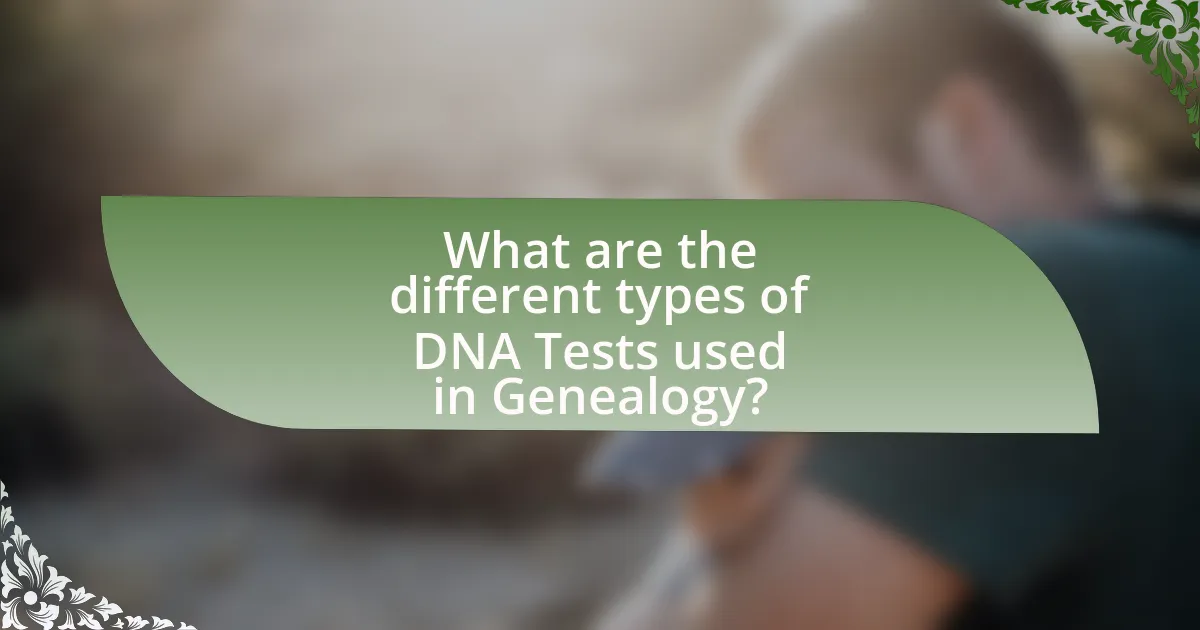
The different types of DNA tests used in genealogy are autosomal DNA tests, Y-DNA tests, and mitochondrial DNA tests. Autosomal DNA tests analyze the 22 pairs of non-sex chromosomes inherited from both parents, providing a broad overview of ancestry and potential relatives. Y-DNA tests focus specifically on the Y chromosome, which is passed from father to son, making it useful for tracing paternal lineage. Mitochondrial DNA tests examine the mitochondrial DNA passed from mothers to their children, allowing researchers to trace maternal ancestry. Each type of test serves distinct purposes in genealogy, enabling individuals to uncover different aspects of their heritage.
What is the difference between autosomal, Y-DNA, and mtDNA tests?
Autosomal, Y-DNA, and mtDNA tests differ primarily in the type of genetic material they analyze and the ancestry information they provide. Autosomal DNA tests examine the 22 pairs of non-sex chromosomes inherited from both parents, offering a broad view of ancestry from all ancestral lines. Y-DNA tests focus exclusively on the Y chromosome, which is passed from father to son, making it useful for tracing direct paternal lineage. mtDNA tests analyze mitochondrial DNA, inherited maternally, allowing researchers to trace direct maternal ancestry. Each test serves distinct purposes in genealogy, with autosomal tests providing the most comprehensive ancestry overview, while Y-DNA and mtDNA tests are specialized for paternal and maternal lineage, respectively.
How does autosomal DNA testing work for genealogy?
Autosomal DNA testing works for genealogy by analyzing the DNA inherited from both parents, which provides a comprehensive view of an individual’s ancestry. This type of testing examines specific locations on the autosomes, the non-sex chromosomes, to identify genetic markers that are shared with relatives. By comparing these markers with those in a large database of other individuals, testers can find potential relatives and estimate the percentage of shared ancestry, revealing connections to various ethnic groups and geographic regions. The accuracy of these results is supported by the extensive databases maintained by testing companies, which contain millions of DNA profiles, allowing for reliable matching and ancestry tracing.
What insights can Y-DNA testing provide about paternal lineage?
Y-DNA testing provides insights into paternal lineage by analyzing the Y chromosome, which is passed from father to son unchanged, allowing for the tracing of direct male ancestry. This testing can reveal the specific haplogroup of an individual, which indicates their ancient ancestral roots and geographic origins. For example, studies have shown that Y-DNA haplogroups can be linked to specific regions and populations, such as the R1b haplogroup being prevalent in Western Europe. Additionally, Y-DNA testing can identify paternal relatives through shared genetic markers, facilitating connections with distant relatives and expanding family trees.
How does mtDNA testing help trace maternal ancestry?
mtDNA testing helps trace maternal ancestry by analyzing mitochondrial DNA, which is inherited exclusively from the mother. This type of DNA remains relatively unchanged over generations, allowing researchers to identify maternal lineage and ancestral origins. Studies have shown that mtDNA can reveal connections to specific populations and geographic regions, providing insights into historical migration patterns. For example, geneticists have utilized mtDNA to trace the maternal lineage of populations in Europe and Africa, demonstrating its effectiveness in genealogical research.
What are the best practices for interpreting DNA test results?
The best practices for interpreting DNA test results include understanding the limitations of the test, consulting with genetic counselors, and considering the context of the results. Understanding limitations is crucial because DNA tests can provide probabilities rather than certainties, and results may vary based on the reference populations used. Consulting with genetic counselors ensures that individuals receive expert guidance on the implications of their results, especially regarding health risks or ancestry information. Additionally, considering the context involves integrating DNA results with family history and other genealogical research to form a comprehensive understanding of one’s heritage. These practices enhance the accuracy and relevance of the interpretation of DNA test results.
How can individuals effectively analyze their DNA results?
Individuals can effectively analyze their DNA results by utilizing online tools and resources that interpret genetic data, such as ancestry and health-related insights. These tools often provide detailed breakdowns of genetic markers, allowing individuals to understand their ethnic backgrounds, potential health risks, and inherited traits. For instance, services like 23andMe and AncestryDNA offer user-friendly interfaces that present DNA results alongside educational resources, enabling users to make informed decisions based on their genetic information. Additionally, individuals can consult genetic counselors for personalized interpretations, especially when concerning health-related findings, ensuring a comprehensive understanding of their DNA results.
What resources are available for understanding DNA matches?
Resources available for understanding DNA matches include genetic genealogy websites, educational articles, and DNA testing company resources. Websites like AncestryDNA and 23andMe provide tools and guides for interpreting DNA match results, including shared ancestry and ethnicity estimates. Educational articles from reputable sources, such as the National Genealogical Society, offer insights into how to analyze and utilize DNA matches effectively. Additionally, DNA testing companies often have customer support and community forums where users can ask questions and share experiences related to DNA matching.
How can individuals get started with DNA-based genealogy research?
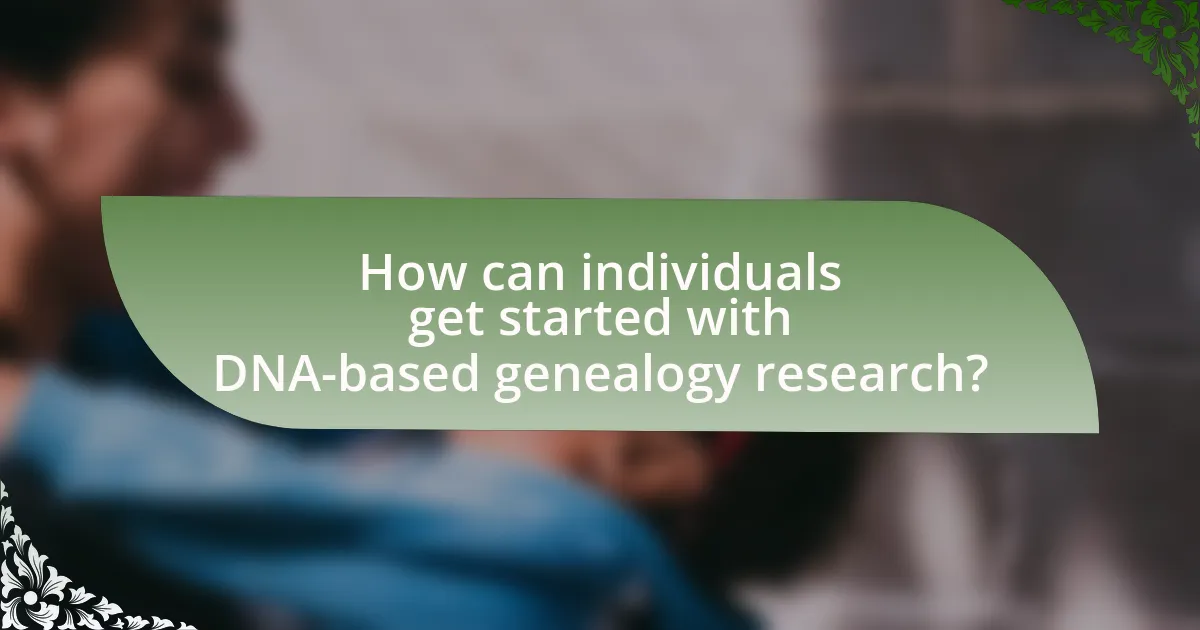
Individuals can get started with DNA-based genealogy research by selecting a reputable DNA testing service, such as AncestryDNA or 23andMe, to obtain their genetic data. After receiving their results, individuals should analyze the provided ancestry composition and potential relatives identified through the service. Engaging with online platforms and communities dedicated to genealogy can further enhance their understanding and provide support. According to a 2021 survey by the Pew Research Center, approximately 27% of Americans have used a DNA testing service for genealogical purposes, indicating a growing interest and accessibility in this field.
What steps should one take before ordering a DNA test?
Before ordering a DNA test, one should research the different types of DNA tests available, such as autosomal, Y-DNA, and mitochondrial tests, to determine which best suits their needs. Understanding the purpose of the test is crucial; for instance, autosomal tests are ideal for ancestry and ethnicity estimates, while Y-DNA tests are specific to paternal lineage. Additionally, individuals should review the privacy policies and data handling practices of the testing company to ensure their genetic information will be protected. It is also advisable to consider the potential emotional impact of the results, especially if they may reveal unexpected family connections or health information.
How can individuals prepare for potential surprises in their ancestry?
Individuals can prepare for potential surprises in their ancestry by conducting thorough genealogical research and utilizing DNA testing services. Engaging in comprehensive family history research helps individuals gather existing information about their lineage, which can provide context for unexpected findings. DNA testing can reveal unexpected relationships, ethnic backgrounds, or even unknown relatives, as studies show that approximately 26% of individuals discover surprising results regarding their ancestry through genetic testing. By combining traditional research methods with modern DNA analysis, individuals can better understand and navigate any surprises that may arise in their ancestry.
What questions should be considered when choosing a DNA testing service?
When choosing a DNA testing service, consider questions regarding the type of tests offered, the accuracy and reliability of results, privacy policies, and the company’s reputation. The type of tests includes options like ancestry, health, or paternity, which can significantly impact the information you receive. Accuracy and reliability are crucial; look for services that provide detailed methodologies and have been validated by scientific studies. Privacy policies should clearly outline how your data will be used and stored, ensuring your genetic information remains confidential. Lastly, the company’s reputation can be assessed through customer reviews and third-party evaluations, which provide insights into user experiences and satisfaction levels.
What are some tips for integrating DNA results with traditional genealogy research?
To effectively integrate DNA results with traditional genealogy research, start by comparing DNA matches with known family trees to identify potential relationships. Utilize tools like chromosome mapping to pinpoint shared segments of DNA, which can help confirm connections. Additionally, incorporate historical records, such as census data and birth certificates, to provide context and support for the DNA findings. Engaging with online genealogy communities can also enhance understanding and provide insights from others who have successfully merged DNA results with traditional methods. These strategies collectively strengthen the accuracy and depth of genealogical research.
How can family trees be updated with DNA findings?
Family trees can be updated with DNA findings by integrating genetic information to confirm or expand existing genealogical connections. DNA testing reveals biological relationships that may not be evident through traditional records, allowing researchers to identify previously unknown relatives or correct inaccuracies in lineage. For instance, autosomal DNA tests can provide insights into ancestry and familial ties across multiple generations, while Y-DNA and mitochondrial DNA tests can trace direct paternal or maternal lines, respectively. This genetic data can then be incorporated into family trees, enhancing their accuracy and depth.
What strategies can enhance collaboration with DNA matches?
To enhance collaboration with DNA matches, individuals should utilize clear communication and shared goals. Establishing a common understanding of research objectives fosters a cooperative environment. Engaging in regular updates about findings and progress encourages ongoing dialogue. Utilizing collaborative tools, such as shared documents or genealogy software, allows for efficient information exchange. Additionally, participating in online forums or groups dedicated to DNA research can expand networks and provide support. These strategies are supported by studies indicating that effective communication and collaboration tools significantly improve project outcomes in genealogical research.
What common pitfalls should be avoided in DNA genealogy research?
Common pitfalls to avoid in DNA genealogy research include over-reliance on DNA results without considering historical context, misinterpretation of genetic matches, and neglecting privacy concerns. Over-reliance occurs when individuals assume that DNA results alone provide a complete family history, ignoring vital records and genealogical research that can clarify relationships. Misinterpretation happens when researchers fail to understand that genetic matches may not indicate direct lineage due to shared ancestry or non-paternity events. Neglecting privacy concerns can lead to ethical issues, as sharing DNA data without consent may violate the privacy of relatives. These pitfalls can hinder accurate research outcomes and lead to misleading conclusions.
How can misinterpretation of results lead to incorrect conclusions?
Misinterpretation of results can lead to incorrect conclusions by causing researchers to draw faulty inferences from genetic data. For instance, if a DNA test indicates a certain ancestry, but the results are misread or misunderstood, individuals may incorrectly assume a familial connection that does not exist. This can occur due to factors such as statistical miscalculations, lack of context regarding genetic markers, or failure to account for population genetics. A study published in the journal “Nature” highlights that misinterpretation of genetic data can result in misleading ancestry claims, emphasizing the importance of accurate data analysis and interpretation in genealogy research.
What are the risks of relying solely on DNA evidence without traditional research?
Relying solely on DNA evidence without traditional research poses significant risks, including misinterpretation of results and overlooking contextual information. DNA evidence can be subject to contamination, degradation, or misanalysis, leading to false conclusions. For instance, a study published in the journal “Forensic Science International” highlighted that DNA evidence can yield inconclusive results if not corroborated with traditional investigative methods. Additionally, DNA does not provide a complete picture of an individual’s identity or familial relationships, as it may not account for non-paternity events or adoptions. Therefore, integrating traditional research methods is essential to validate DNA findings and ensure accurate genealogical conclusions.
